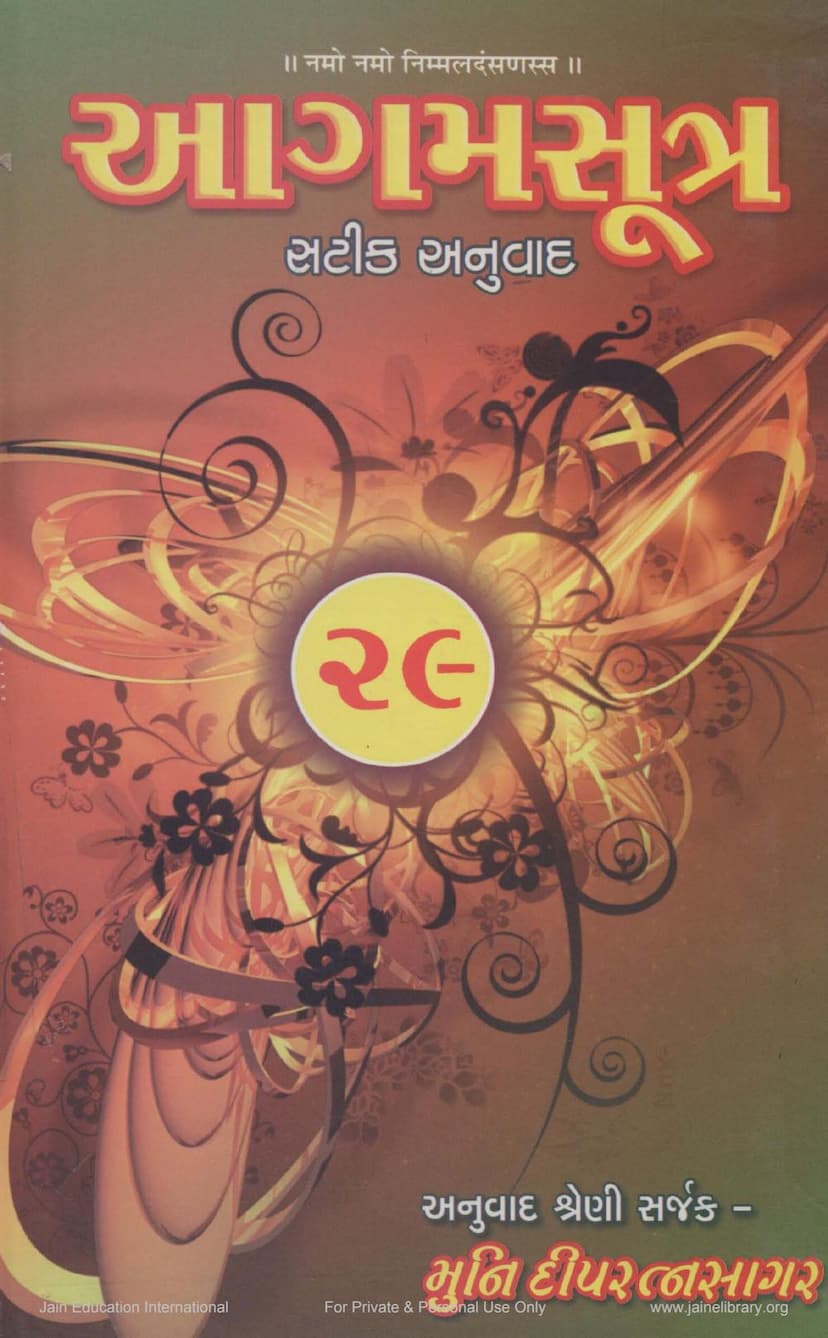Agam Satik Part 29 Nisith Aadi Sutra Gujarati Anuwad
Added to library: September 1, 2025

Summary
This comprehensive summary is based on the provided Jain text, "Agam Satik Part 29 Nisith Aadi Sutra Gujarati Anuwad," authored by Dipratnasagar and Deepratnasagar, and published by Shrutnidhi Ahmedabad. The catalog link is also provided for reference. This text is part of a larger series of Agama Sutra commentaries.
Book Title: Agam Satik Part 29 Nisith Aadi Sutra Gujarati Anuwad Author(s): Dipratnasagar, Deepratnasagar Publisher: Shrutnidhi Ahmedabad Content: This volume (Part 29) of the Agama Sutra commentary series focuses on five Chedasutras. These are considered fundamental Jain scriptures dealing with conduct, discipline, and expiation for monks and nuns.
The five Chedasutras included in this volume are:
- Nisith (નિશીથ): This is the first Chedasutra and is the primary focus of the detailed translation presented in the provided pages. Nisith Sutra primarily deals with the "doshas" (faults or transgressions) that can occur on the path of renunciation (samyama) and the corresponding "prayashchitta" (expiations or penances) for these faults.
- Brihatkalpa (બૃહત્કલ્પ): The second Chedasutra, discussing various rules and regulations.
- Vyavahar (વ્યવહાર): The third Chedasutra, focusing on the practical aspects of monastic conduct and daily life.
- Dashashrutaskandha (દશાશ્રુતસ્કંધ): The fourth Chedasutra, which elaborates on different aspects and stages of spiritual practice.
- Jitakalpa (જીતકલ્પ): The fifth Chedasutra, which is considered a replacement or alternative to the ancient Panchakalpa Sutra. It also deals with expiations and conduct.
Key Information and Themes from the Text:
- Commentary (Satik Anuwad): The title indicates that this is a "Satik Anuwad," meaning it is a translated text accompanied by a commentary. While the provided text is a translation of the original sutras, the commentary itself is mentioned as being available in other published works by the same publisher, particularly in the "Agam Sutra Satik" series.
- Emphasis on "Sutranuvad": The author, Muni Diperatnasagarji, explicitly states that due to differing opinions among respected Acharyas regarding the publication of commentaries on these specific Chedasutras, this volume only provides the "Sutranuvad" (translation of the sutras) for these five Chedasutras. The full commentary (Niryukti, Bhashya, Churni, Vritti) is available in the "Agam Sutra Satik" series.
- Nature of Chedasutras: The text describes Chedasutras as primarily dealing with "prayashchitta" (expiations) and containing detailed descriptions of faults and their remedies.
- Nisith: Focuses on the faults incurred on the path of renunciation and their expiations.
- Brihatkalpa: Deals with purification of conduct and expiations related to various actions.
- Vyavahar: Encompasses the practical rules of conduct for monks and nuns, including detailed orders and expiations.
- Dashashrutaskandha: Covers various topics, including "asamadhisthan" (states of disquietude or disturbance), "shabal dosh" (mixed faults), and other related subjects.
- Jitakalpa: Acts as a replacement for the Panchakalpa Sutra and discusses atonement, expiation, and faults.
- Structure of the Translation: The translation of the Nisith Sutra, in particular, is presented in an organized manner, divided into "Udeshas" (sections or chapters). The provided pages detail Udeshas 1 through 10 of the Nisith Sutra.
- Content of Nisith Sutra (as translated):
- The Nisith Sutra is shown to detail a wide range of specific actions that are considered faults or transgressions for Jain ascetics.
- Each transgression is linked to a specific form of "pratyashchitta" (expiation).
- The faults cover a broad spectrum of conduct, including:
- Handling of bodily parts (e.g., touching, massaging, cleaning).
- Use of specific substances (e.g., oils, powders, water).
- Interaction with laypeople or followers of other religions for obtaining necessities or assistance.
- Improper use of tools and implements (e.g., needles, scissors, ear picks).
- Misuse of borrowed items.
- Improper handling of containers and garments (e.g., patching, tying).
- Actions related to personal hygiene and adornment (e.g., bathing, perfuming, cutting nails, shaving).
- Improper disposal of waste.
- Actions related to prohibited places or times.
- Interactions with royalty and authorities.
- Practices deemed detrimental to spiritual discipline, such as associating with impure individuals, engaging in forbidden activities.
- Faults related to eating, drinking, and taking alms in improper ways or from improper sources.
- Transgressions related to maintaining monastic life, such as incorrect use of robes, bedding, or other essential items.
- Activities deemed frivolous or leading to attachment, such as singing, dancing, or listening to music.
- Actions that compromise purity and detachment, such as interacting inappropriately with the opposite sex or engaging in actions that could lead to sensual indulgence.
- Specific rules about travel, dwelling places, and the treatment of fellow ascetics.
- The text also includes detailed descriptions of how different types of faults lead to different penances, often categorized by the severity of the fault and the period of penance (e.g., monthly, bi-monthly, quarterly, etc., referred to as 'Parighar').
- Sponsorship and Dedication: The initial pages highlight the significant financial support received for this translation project from various Jain Sanghs (communities) and individuals. This reflects the importance placed on making these scriptures accessible. Numerous Acharyas and religious leaders are acknowledged for their inspiration and contribution, underscoring the lineage and respect within the Jain tradition.
- Publication Details: The publisher is Shrutnidhi Ahmedabad. The catalog link is provided. The text also includes publication details like type setting and printing press information.
- Author's Intent: The author, Muni Diperatnasagarji, is presented as the creator of this translation series, aiming to make the complex Agama Sutras accessible to a wider audience, especially those who may not have access to the original Prakrit or Sanskrit languages.
In essence, Part 29 of the "Agam Satik Anuwad" series provides a foundational translation of crucial Jain Chedasutras, primarily focusing on the Nisith Sutra. It meticulously outlines the rules of conduct for ascetics and the expiations required for any deviations, offering a glimpse into the strict ethical and disciplinary framework of Jain monasticism. The emphasis on meticulous detail in the translation and the acknowledgment of the extensive support highlight the commitment to preserving and disseminating these sacred texts.